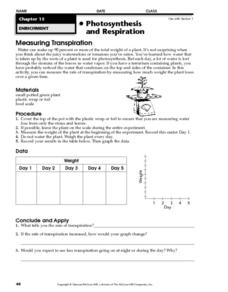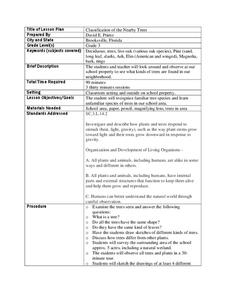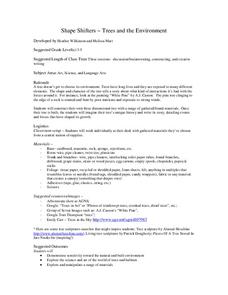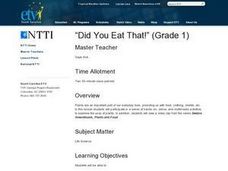Curated OER
Photosynthesis: Using the Sun to Make Food
For this photosynthesis worksheet, students learn how plants use the sun to convert energy into food. They then answer 10 questions using the information they just read. The answers are on the last page.
Curated OER
Wetland Plant Detectives
Sixth graders identify plants in the wetlands. For this plant detectives lesson, 6th graders complete a scavenger hunt on a local reserve, record observations, and respond in their journals.
Curated OER
Tree Birthdays
Young scholars investigate the growth of trees. In this tree growth lesson, students discover that trees make a ring each year they live. Young scholars use new voabulary such as bark, phloem, and cambuim to talk about tree parts....
Curated OER
Measuring Transpiration
In this transpiration worksheet, students will conduct an experiment to measure the rate of transpiration from a plant by measuring how much weight the plant loses over 5 days. Students will record their data and create a graph of the...
Curated OER
Do Plants Need Water?
First graders observe the effects of varying amounts of water, sun, and air on lima bean plants. They also predict and describe their outcomes in a written report.
Curated OER
Do Medicines Grow on Trees and Plants?
Students study the importance of preserving rainforest. They investigate the uses of rainforest plants for medicinal uses by participating in rainforest immersion activities.
Curated OER
Growing Things - Structure of Plants
For this plant worksheet, students read about plants and growing things from a seed. They then answer the 14 questions on the worksheet. The answers are on the last page.
Curated OER
Classification of the Nearby Trees
Third graders practice using classification techniques to identify local trees. In this plant life instructional activity, 3rd graders discuss how trees differ from other plants and what characteristics are unique to trees alone....
Curated OER
Forest Management ~ Diseases and Pests that Effect a Good Harvest Stand
The forestry presentation found here lists and describes a variety of tree diseases. A few unappetizing photos are included to show symptoms of some of these diseases, or the insects and fungi that cause them. If you have a class that is...
Curated OER
Survival of the Fittest Microbes
Students explore the harsh conditions of Spain's Rio Tinto River and research the microbes that nonetheless manage to thrive there. They synthesize their knowledge by creating a reality television show set in the Rio Tinto with microbes...
Curated OER
Bird Up
Third graders identify basic physical and behavioral characteristics of birds and how they adapt to their environments. To organize and share scientific information with peers. They discuss similarities and differences among birds....
Curated OER
Shape Shifters- Trees and the Environment
Students make a tree sculpture. In this trees and the environment lesson, students learn about the parts of a tree, discuss what a tree needs in order to grow, find images of trees in art and nature, use various materials to create a...
Curated OER
Growing Up (And Around, and Down...) Exploring Plant Growth
Students build plant growing structures. In this plant growth lesson, students plant growth structures such as a garden tepee or a crawl through tunnel. They grow plants that are appropriate for the structure.
Curated OER
The Dirt on Plants
Students draw and label the four parts of a plant. They describe changes that are part of the common life cycle. Students follow various one and two step directions. They are asked to discuss that they can recall about plants.
Curated OER
WET Science Lesson #3: Comparison of Aquatic and Terrestrial Plants
Elementary life science explorers compare and contrast aquatic and terrestrial plants (elodea and soybeans) in a Venn diagram. Some background information is provided to support direct instruction, and general instructions are provided...
Curated OER
"Did You Eat That!"
First graders investigate why plants are an important part of our everyday lives, providing us with food, clothing, shelter, etc. In this lesson students participate in a series of hands-on, online, and multimedia activities to examine...
Curated OER
Plant Growth & Development
Learners share what they know about plants and discuss what else they would like to know. The teacher evaluates students' prior knowledge of plants to inform future instruction. Learners practice observation and prediction skills.
Curated OER
Planting the Seed
Learners plant their seeds and collect and organize their own materials for planting. They also set up their planters with wicks, fertilizer, potting mix, and seeds. Finally, students write their names on planter markers with a ball...
Curated OER
Observing the Growth Spurt
Middle schoolers notice a growth spurt in their Brassica plants and closely monitor this growth by measuring their plants and predicting the next day's growth based on the pattern of their data. They also read and highlight the...
Curated OER
Harvesting and Threshing the Seed
Learners harvest and thresh the seeds. They count the seeds and compare that number with the original number of seeds planted (8) to determine their profit or loss. Finally, students think about additional questions they have about...
Curated OER
Growing Jack and the Beanstalk Plants
First graders investigate how plants grow by growing their own "beanstalk", (after reading "Jack and the Beanstalk") and record their observations daily in a science journal.
Curated OER
Plants
First graders learn the basic needs of plants, label the major parts of a plant and name their uses. They also use a KWL chart.
Curated OER
Plants
Second graders examine the characteristics of plants. As a class, they brainstorm a list of items plants need in order to survive. In groups, they complete various experiments in which they discover the functions of the parts of the plant.
Curated OER
Birth, Growth, And Development
Students understand that all living things have a life cycle that includes being born, developing into an adult, reproducing, and eventually dying.

























